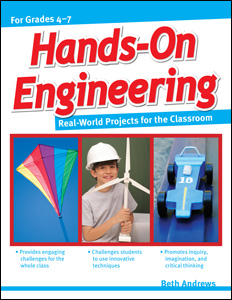Prufrock Press publishes a number of science books whose titles begin with “Hands-On,” but these are not a series of similar books as you might expect. Each one is by a different author and uses a different approach. Thus far I have reviewed Hands-On Ecology and 101 Hands-On Science Experiments. Hands-On Engineering is my favorite of these three books, probably because we did some of these types of activities with my sons, and they were among the most memorable of their learning experiences.
Hands-On Engineering teaches students in grades four through seven to think like an engineer who has to work through all of the stages to design a product to serve a particular purpose. The book has 26 “challenges” or lessons, although extension activities provide options for many more learning opportunities.
Hands-On Engineering isn’t your typical science experiment book. Instead, it is a good example of the direction many educational resources are moving. Lesson presentations are dependent upon material from various websites that are accessed through the internet. (Because the sites are integral to the lessons, the publisher provides a free PDF companion book that has active weblinks to the referenced sites so that you need not type in long URLs to try to bring them up.) The sites provide specific information, illustrations, or videos on the lesson’s topic. For example, the lesson on windmills has a link to a Siemens site that advertises their wind turbines. A 3D animated video on that page that runs about two minutes shows how wind turbines operate. Students will then create two windmills and compare their rotation. Another brief video hosted on Vimeo appears to be created by an amateur. It is more informational about actual windmills in California. For a lesson about the engineering principle behind hammocks, students read rather than watch a video. There’s an article on the history of hammocks. There’s also a link to a page on a website that sells hammocks and other items, but the site includes a page with detailed instructions for making your own hammock. Students are expected to apply some of the construction techniques as they construct a smaller, simpler hammock for their experiment.
Lessons have step-by-step presentation procedures that tell the teacher what to say most of the time and incorporate the websites at appropriate points. The teacher does need to have read over the material and previewed the websites in advance to be able to teach a lesson, but it won’t take long to do so for most lessons.
With the background information gleaned from these introductory activities, students then proceed to the rest of the lesson. Every lesson has reproducible student pages with instructions for their activity and space to record data and observations. Many of the student pages include “individual activity” sections that students will complete before moving on to the hands-on activity. Individual activities often include words to define or questions for students to answer to make sure they understand the concept(s) presented in the introduction. Sometimes students will also draw something; for example, in one lesson they draw and label a kite, identifying the five key components.
Every lesson explores engineering principles behind machines or inventions with which students are familiar—things like airplanes, bridges, bungee jumping, boars and trampolines. Experiments use simple resources such as paper, straws, tape, rubber bands, twine, clay, clothespins, Popsicle sticks, Styrofoam plates, corks, and film canisters. A materials list is at the front of the book.
Optional extension activities at the end of each lesson often provide enough research and activity for another class session. Extension activities might include research, reading, videos, writing, drawing, or experiments.
The book is written for classroom groups. While you can use it with a single child, it really is best when two or more students each work on their individual projects, or two or three students work together on joint projects. Part of the fun is comparing results and trying to win the competition with their own designs. While the suggested grade range is grades four through seven, the activities are likely to be so much fun that all ages will want to be involved.










